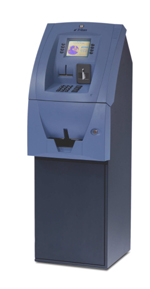News
Triton picks up the production pace
With the 9100, an ATM that made it off the drawing board and onto the production line in less than six months, Triton signals its intent to become a lean, mean manufacturing machine.
April 23, 2002
GULFPORT, Miss. -- While freedom of choice is generally seen as a positive thing, that's not necessarily true when it comes to ATM manufacturing – especially in an increasingly price-sensitive market.
That's why Triton's newest machine, unveiled at its fifth annual Distributor's Conference here, offers the company's dealers "exactly one choice," said Bill Jackson, Triton's chief technical officer. "The only option now is how many (of the machine) do you want."
On the fast track
The new machine, the 9100, was developed on the company's fastest track yet. The design concept was approved in November of 2001, with an engineering model introduced this January and a prototype rolled out in February.
 |
Triton's newest ATM, the 9100, has the same curvy shape and dark blue color as its 9700. |
Seven beta units are currently in the field, Jackson said, and it's already been certified by Core Data Resources, EFTLogix, eFunds, Lynk Systems and Genpass Technologies.
Jackson said that sample shipments will begin next week, followed by volume shipments on May 13. In addition to the United States market, Triton expects to ship the 9100 to Canada and the UK beginning next month.
It will be Triton's lowest sticker model, approximately several hundred dollars below the wholesale list price of the Mako.
It will also replace the Mako, which has been the much-maligned black sheep of Triton's product family since its spring 1999 release. Triton will provide technical support for the discontinued Mako for the next five years, Jackson said.
Jackson candidly admitted that the development of the 9100 was driven by the success of Tranax Technologieswith its MiniBank 1000, a low-end unit that helped the Triton archrival grab 22,000 sites in the past three years.
The short list
Among the 9100's features: a 5.7-inch monochrome, graphics-capable screen; a 2400 baud modem; a single 1,000-note cassette; Triton's new self-manufactured dispenser, the TDM 100; and a SPED (Secure PIN Entry Device) that offers Triple DES capability.
Optional accessories will be limited to a topper sign and an anchor bolt kit.
The short list is a dramatic departure from the 9600 product line which, according to Jackson, offers 31,000 possible configurations across 12 different models.
Because of this, all 9600s are built to order. Triton keeps a large number of parts on hand and spends a significant chunk of time in its test labs to ensure that it can produce the various configurations. Building to order also slows turnaround time, a key requirement in the increasingly commoditized low end of the retail market.
Many of the 120 or so in attendance at the conference welcomed the announcement. Bart Carter, president of Las Vegas-based ATM Merchant Systems, said that the 9100 will open up opportunities at non-traditional sites such as packaging stores.
"Our best locations are still doing the same (transaction) numbers. It's the low-volume sites that are bringing down those transaction averages," he said. "Now we've got a machine that I don't have to feel bad about taking in there. For 90 bucks a month, they can easily cover the cost of the machine."
Neil Clark, president of Billings, Mont.-based ATM Express, said the 9100, with a locking cash cassette and UL 291 business hours safe, was a more secure unit than the Mako. "That's important in a lot of our markets like the c-stores," he said.
Clark also liked the looks of the 9100, which has the same curvy shape and dark blue color as the 9700, which was introduced at last year's Distributor's Conference.
The speed's the thing
Lew Burns, chief executive officer of Triton parent Dover Industries, was notably pleased with the 9100's rapid introduction. "Speed to market is very critical," said Burns in a short address to the crowd. "We like to see new product development occur in months, not years."
Triton is also working to shorten its production cycle on the higher end of its product line. Many of what were options on the 9600 – including a 256-color screen, 36K modem, two megabytes of memory and electronic lock-are standard features on the 9700. So while the 9700 is still built to order, it offers dealers just 384 possible combinations.
Triton is positioning the 9700 as the successor to the 9600, Jackson said. Beta units appeared in December of 2001, production units began rolling off the line this February and "hundreds" are in the field, he said.
The company is already planning its next incarnation of the 9700, a PC-based model that it expects to introduce by year's end. Jackson said it will likely run on a Linux, Windows CE or Windows Embedded XP operating system.
With 50,000 installations in 17 countries, Triton isn't about to discontinue the 9600, Jackson assured the crowd. "We'll let you tell us when it's time to retire it," he said.
Included In This Story
Triton Systems
Triton FI based products • NO Windows 10™ Upgrade • Secured locked down system that is virus/malware resistant • Flexible configurations - Drive-up and Walk-up • Triton's high security standards • NFC, anti-skim card reader, IP camera and level 1 vaults are all options • Triton Connect monitoring • Lower cost









